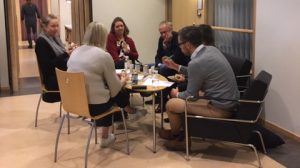How should recycling be modeled in LCA?
The method for modeling material recycling can have a decisive impact on the environmental assessment of products with a high content of recycled material or material that is recycled after use. How recycling should be modeled in LCA has been discussed since the 90’s.
On November 7, the Swedish Life Cycle Center research project “Modeling of recycling” gathered 16 life cycle professionals from academia, research institutes, industry and government agencies to increase the knowledge on how recycling can be modeled in LCA. The overall aim of the meeting was to discuss and evaluate the methods based on the results from the project case studies and to start the consensus process on how to model recycling in LCA.
“This project is in line with the Swedish EPA’s objectives both on scientific base for developing policy tools and decisions, relevant input to ongoing processes in EU/internationally and involvement of stakeholders… It is a well-managed project that builds on the Swedish Life Cycle Center’s core strengths: LCA expertise and a network that comprise a variety of actors.” Cecilia Mattsson, Swedish EPA & project participant
The day was intense with a review of the completed case studies* and the afternoon with two rounds of workshops to go into the so-called consensus process. Here, the participants discussed, the methods evaluated in two steps (before and after the case studies) with focus on internal applications of LCA (e.g., product and process development), external communication (e.g., product declarations and other marketing) and policy making. In support of the discussion, the participants had access to a preparatory study that consists of – Methods for modelling recycling; Criteria for assessing allocation methods and Assessment of methods, and the results from case studies. Below you will find a list of methods for recycling that have been evaluated.

We asked the project participant Pernilla Cederstrand, Essity, to give us her reflections from the meeting and project from an industry point of view.
– What was the most important learnings from the meeting?
“The variety of case studies shows the importance of testing methods with industry relevant data. Many conclusions are common but there are some differences and not the least different findings for/from the different case studies.”
– What makes this project interesting for your industry?
“With the increased focus on circularity, including increased focus on renewable materials, it is very important for us to understand the mechanisms of different allocation approaches and the robustness in the conclusions from the assessments we make.
The project covers a great mix of different stakeholders and competences and facilitates very valuable discussions. I look forward to the continued work.”
Tomas Ekvall, project manager for the Modeling of recycling project summarized the meeting.
“This project is not just about research but also about sharing of experience and mutual learning. In this context it is particularly good to hear that project partners are happy with the progress of the project and that they have already learnt a lot. The case studies were an important and successful part of the learning process.”
More information about the project
Methods for recycling that will be presented and have been evaluated is: Simple cut-off; Cut-off with economic allocation; Cut-off plus credit; Allocation to material losses; Allocation to virgin material use; 50/50 methods; Quality-adjusted 50/50 methods; Circular Footprint Formula; Market price-based allocation; Market price-based substitution; Price-elasticity approaches and Allocation at the point of substitution.
*Case studies have been conducted at Essity Hygiene and Health, Volvo AB (Buses), Tetra Pak, Scania, SSAB, Outokumpu and KTH (On concrete) where the outcome of the different methods has been compared through different materials and scenarios.
Text: Sara Palander / Jenny Lagergren
Photo: Jenny Lagergren
